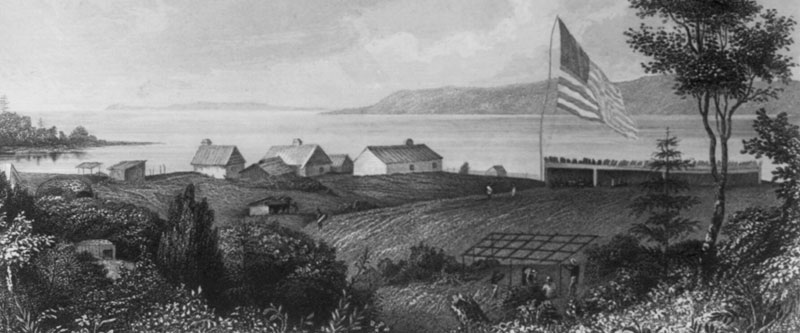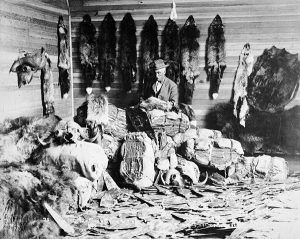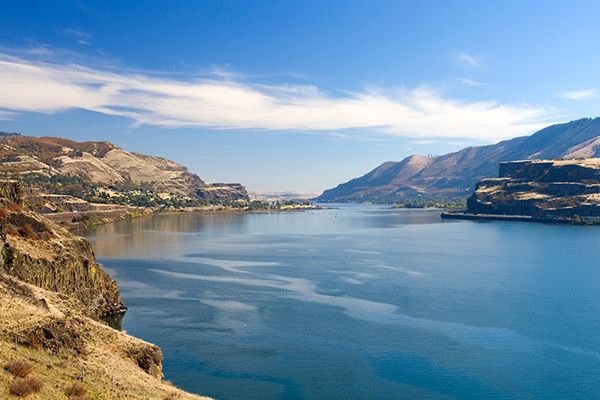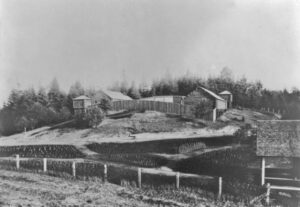Fort Astoria, Oregon, was the primary fur trading post of John Jacob Astor’s Pacific Fur Company.
The Pacific Fur Company was established as an American Fur Company subsidiary to build commercial stations on the Pacific Coast. John Astor recruited several North West Company partners and employees into the Pacific Fur Company, including Donald Mackenzie, Alexander MacKay, and Duncan McDougall. To create these new fur trade locations, Astor planned to send detachments of laborers and officers overland on a route similar to one taken by the Lewis and Clark Expedition and on merchant vessels that rounded Cape Horn for the Columbia River.
In 1810, John Astor sent the Astor Expedition to the Northwest to establish the first permanent U.S. settlement on the Pacific coast. A maritime contingent of Pacific Fur Company staff was sent on board the Tonquin while another party traveled overland from St. Louis, Missouri. The Tonquin was used to carry a detachment of employees under the command of Captain Jonathan Thorn. After several days were spent surveying the mouth of the Columbia River, 33 men disembarked on April 12, 1811.
By May 1811, company employees had built Fort Astoria on the south bank of the Columbia River, seven miles from the river’s mouth. The fort was built of bark-covered logs that enclosed a stockade with guns mounted for defense. It was built amid the Clatsop and Chinook peoples’ lands. It was the first American-owned settlement on the Pacific coast of North America.
A Northwest Company explorer David Thompson was the first European to navigate the entire length of the Columbia River in 1811. Thompson reached the partially constructed Fort Astoria at the mouth of the Columbia River, arriving two months after the Pacific Fur Company’s ship, the Tonquin.
When an overland party joined them in February 1812, the Pacific Fur Company laborers had constructed a trading store, a blacksmith’s shop, a house, and a storage shed for pelts acquired from trapping or trading with the local Native Americans. The traders arranged cannons around the perimeter for defense. The post was to serve as an administrative center for various Pacific Fur Company satellite forts, such as Fort Okanogan.
The fort’s inhabitants differed greatly in background and position and were structured into a corporate hierarchy. The fur-trading partners of the company were at the top, with clerks, craftsmen, hunters, and laborers in descending order.
The War of 1812 caused the Pacific Fur Company to fold, as it was too isolated to expect military protection or support from the United States. The Montreal-based North West Company bought out the assets of the Pacific Fur Company in 1813, including Fort Astoria. They renamed it Fort George and utilized it as the headquarters of its most western operations, primarily based along the Columbia River. In the next few years, the North West Company expanded the original footprint of Fort Astoria from 150 by 150 feet to 190 by 210 feet and constructed a 170-foot-long warehouse. It was substantially larger and better armed, including six 6-pound cannons, four 4-pound cannons, two 6-pound mortars, and seven swivels. Laborers also expanded their agricultural fields. North West Company personnel at Fort Astoria in 1817 stood at 150, nearly all French Canadian, with 30 Hawaiian laborers (Kanakas). At the time, the Northwest Company had no competition for the land-based fur trade in the region and became an important port of call for the Maritime Fur Trade.
The Treaty of 1818 established joint U.S. – British occupancy of territory west of the continental divide to the Pacific Ocean. At that time, there were about 50 employees at Fort George, over half being Hawaiian Kanakas.
In 1821 the Hudson’s Bay Company incorporated Fort George into its collection of posts after absorbing the North West Company. Fort George continued to function as the primary post of the Columbia Department until 1825. The opening of Fort Vancouver in 1825 was planned to allow for a better-placed headquarters for the Columbia Department. Fort George was then abandoned, and neighboring native villagers began to seasonally reside there.
The arrival of American naval merchants on the Columbia River necessitated the reopening of Fort George in 1829. While the post was gradually rebuilt, the dilapidated condition and extensive repairs required forced the sole clerk to live in a tent during the winter. The fort was rebuilt, measuring 20 feet wide by 60 feet long. Along with two minor buildings, there was also a small warehouse. It was then utilized as a fishery station and a small outer depot that focused on Indian trade on the lower river. After the sinking of two Hudson Bay Company ships — the William and the Ann, at the mouth of the Columbia necessitated using the trading post to guide ships inland. Beginning in 1830, the company continuously used the location in a small capacity.
In 1833 the post had four staff members, including an English clerk, a Scottish field manager, and two Hawaiians. Throughout the 1830s and 1840s, several men served as Fort George’s managing officers. The growing salmon harvesting operations of the Hudson’s Bay Company were focused on the fisheries surrounding Fort George. The company used the salmon to feed its employees, as well as exporting some to the markets of the Kingdom of Hawaii.
In 1838, Captain Edward Belcher of the visiting HMS Sulphur described the post: “A small house for Mr. Birnie, two or three sheds for the Canadians, about six or eight in number, and a pine stick with a red ensign, now represented Fort George. Not a gun or warlike appearance of any kind remains. One would rather take it for the commencement of a village than any noted fort.”
In 1846 the Oregon Treaty ended the Oregon Boundary Dispute, with Britain ceding all rights to the mainland south of the 49th Parallel to the United States.
However, the fur trade would remain under British control until American pioneers following the Oregon Trail began filtering into the port town in the mid-1840s.
The Fort Astoria Site was added to the list of National Historic Landmarks on November 5, 1961. A reconstructed blockhouse marks the site at 1498 Exchange St, Astoria, Oregon.
© Kathy Alexander/Legends of America, updated January 2023.
Also See:
Forts & Presidios Across America
Trading Posts of the Fur Trade
Sources:
Astoria, Oregon
Oregon Encyclopedia
Oregon History Project
Wikipedia




